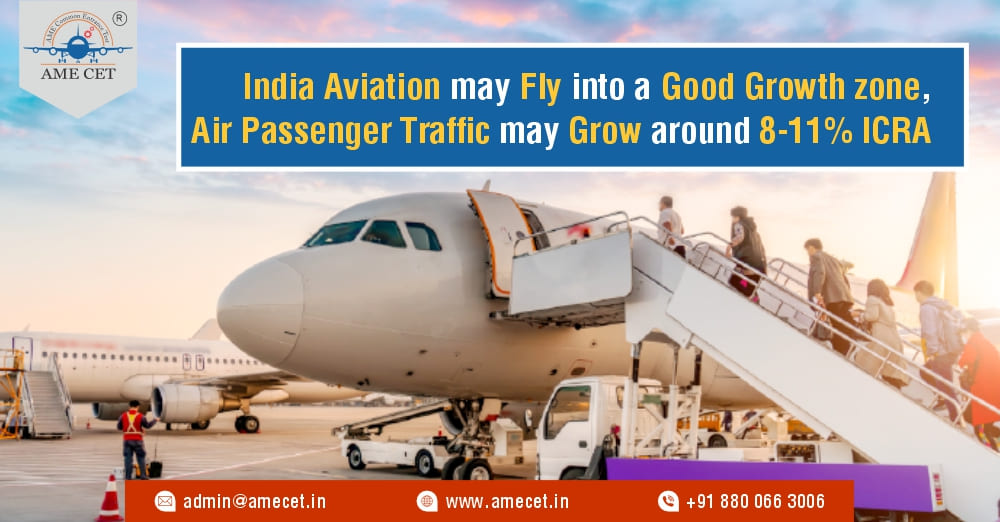
The Indian aviation industry, a vital component of the country’s transportation infrastructure, is on the brink of a significant growth spurt, according to recent projections by ICRA, a prominent credit rating agency. With expectations of air passenger traffic rising by approximately 8-11%, this development marks a positive turning point for an industry that has faced numerous challenges in recent years, offering excellent prospects for aviation aspirants interested in courses like aircraft maintenance engineering (AME), pilot training, and aeronautical engineering.
Recovery Post-Pandemic The COVID-19 pandemic severely impacted global aviation, leading to a dramatic decline in passenger numbers. However, as restrictions have eased and consumer confidence has returned, the Indian aviation sector is witnessing a remarkable recovery. The anticipated growth in passenger traffic reflects a resurgence in travel demand and highlights opportunities for students pursuing careers as pilots, AME professionals, or aeronautical engineers.
Factors Driving Growth Several key factors are contributing to this optimistic outlook for India’s aviation sector:
-
Increased Demand for Travel: With restrictions lifting and a growing desire for leisure and business travel, there is a resurgence in air travel demand. This growing interest makes it an ideal time for students interested in aviation courses such as pilot training, AME, and aeronautical engineering.
-
Economic Growth: India's steady economic growth, coupled with rising disposable incomes, means more people can afford air travel. This trend will likely result in greater demand for trained professionals like AMEs, pilots, and aeronautical engineers.
-
Infrastructure Development: The government’s investment in airport infrastructure, expansion of facilities, and increasing airport capacity will enhance travel experiences, making it a promising time for those pursuing ground staff training, airport management, and aviation maintenance courses.
-
Low-Cost Carriers (LCCs): The rise of low-cost airlines has made air travel accessible to a broader population. This democratization of air travel indicates a strong demand for AME professionals, pilots, cabin crew, and aeronautical engineers.
-
International Connectivity: The introduction of new routes and increased flight frequencies by airlines will create ample opportunities for professionals in areas like aircraft maintenance engineering, pilot training, and aviation ground staff.
Competitive Landscape The Indian aviation market's mix of full-service carriers and low-cost airlines, including major players like Indigo, Air India, and Vistara, fosters healthy competition. This environment not only benefits consumers but also creates a demand for skilled personnel trained in aviation-related courses like AME, pilot training, aeronautical engineering, and ground handling.
Safety and Health Measures The aviation industry has adopted rigorous health and safety protocols, such as enhanced sanitization and contactless check-in. This commitment to safety emphasizes the need for trained professionals in aircraft maintenance engineering, ensuring aircraft are maintained to the highest standards.
Environmental Considerations As the aviation sector expands, there is growing awareness of its environmental impact. This focus on sustainability presents opportunities for aeronautical engineering students to work on developing fuel-efficient aircraft and sustainable aviation fuels.
Challenges Ahead While the outlook is positive, the industry must navigate several challenges to sustain this growth trajectory:
-
Rising Fuel Costs: Fluctuating oil prices can impact airline profitability, making cost-effective aircraft maintenance and efficient operations by AME professionals even more crucial.
-
Regulatory Hurdles: Navigating complex regulatory environments requires well-trained ground staff and aviation management professionals who understand compliance and policy changes.
-
Infrastructure Bottlenecks: As airport expansions are underway, skilled aviation professionals like ground staff and airport managers will play a vital role in ensuring smooth operations and a positive passenger experience.
-
Global Economic Conditions: The aviation sector is sensitive to global shifts, making it essential for those entering the field, such as pilots, AMEs, and aeronautical engineers, to adapt and remain flexible in their careers.
Future Prospects The Indian aviation sector's promising future will see airlines ramping up operations, investing in newer aircraft, and enhancing service offerings. This growth presents excellent career opportunities for students interested in aviation courses like pilot training, aircraft maintenance engineering, aeronautical engineering, and ground staff roles.
Conclusion The ICRA’s projection of an 8-11% growth in air passenger traffic underscores a pivotal moment for India’s aviation industry. As the sector rebounds from pandemic challenges, increased travel demand, economic growth, and infrastructure development offer exciting opportunities for students pursuing aviation courses such as AME, pilot training, aeronautical engineering, and ground staff training. By addressing potential challenges proactively and continuing to prioritize safety, the Indian aviation industry is set to soar to new heights, benefiting airlines, passengers, and the nation.
Category
-
Aircraft Maintenance Engineering (DGCA) (62)
-
(269)
-
Cabin Crew (1)
-
Aerospace Engineering (3)
-
Aeronautical Engineering (2)
-
Airport Management (5)
-
Aircraft Maintenance Engineering (EASA) (6)
-
Airport Ground Staff (1)
-
Commercial Pilot License(CPL) (51)
-
Aircraft Maintenance Engineering (BTech/BE) (1)
-
B.Sc. in Aviation (1)
-
AME CET (5)
